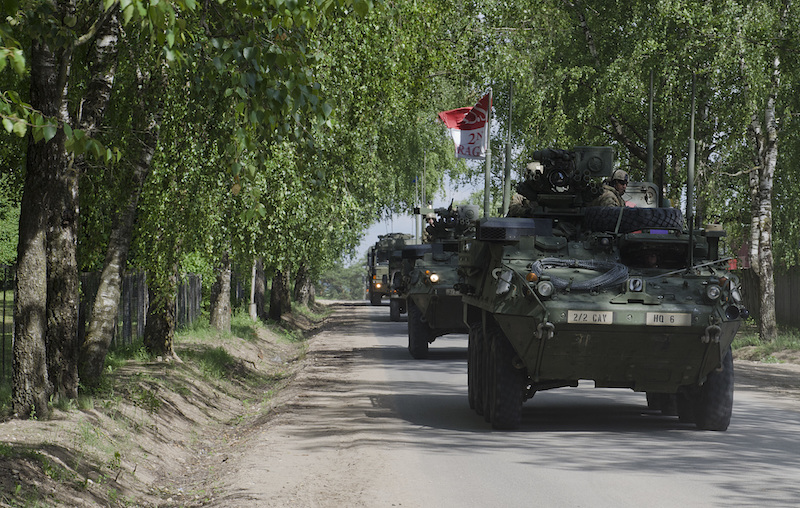The Suwalki Gap is a small strip of land that stretches 95-kilometers and connects Poland’s border with Lithuania. On either end of this strip are Belarus and Kaliningrad Oblast—both under the sphere of Russian influence. Kaliningrad was originally part of Germany before being annexed by the USSR in 1945, and is home to Russia’s Baltic Fleet.
This small corridor is the link that divides NATO allies from Russian ones. If Russia were to seize control of this corridor, then Baltic NATO members would be cut off from their NATO allies; Estonia, Latvia, and Lithuania would risk being isolated from the rest of the NATO members in Western Europe. Put simply, the Suwalki Gap is NATO’s point of vulnerability.
In the event that the Suwalki Gap becomes enveloped by Russia, the land link between the Baltics and the West would be severed and points of access would rely on air or naval forces. Even with its air force capabilities, the Alliance would still be limited given Russia’s investment in anti-aircraft missiles in Kaliningrad. Rotating NATO troops in the Baltics may not be enough to deter a Russian invasion. After all, from Poland, mobilization would require transiting the Kaliningrad enclave—a Russian territory—to reach the other Baltic states. Lieutenant General Ben Hodges, the commander of U.S Army Europe, expressed his concerns that consolidation of Russian military support in Kaliningrad poses the risk of blocking NATO access to the Baltic Sea.
A recent RAND Corporation report, Reinforcing Deterrence on NATO’s Eastern Flank, has estimated that it would take Russian forces between 36 and 60 hours to reach the capitals of Latvia and Estonia. The resulting takeover could lead to a fait accompli in the Baltics, or present NATO with unattractive options given Article 5 obligations.
One option proposed by the authors involves a counteroffensive response that would put the leaders of Estonia and Latvia in the difficult position of choosing whether to fight an insurgency within its borders or not. For these leaders, the danger of inland combat, or the possibility of it, must take into consideration Estonia’s (~30%) and Latvia’s (~30%) sizeable ethnic Russian populations. In Estonia, for instance, citizenship requirements following its independence in 1991 excluded those who were not citizens of the state prior to its annexation into the USSR in 1940. These requirements ergo made it more difficult for ethnic Russians to obtain Estonian citizenship post-WWII. Because of this, propaganda aimed at abetting social fragmentation becomes an effective manipulation tactic. Should internal ethnic tensions heighten at the prospect of conflict between the Alliance and Russia, social unrest could lead to destabilization in Estonia. The security challenges of engaging or entertaining a counteroffensive response isn’t without risk.
Another unattractive option would be for NATO to concede the Baltics to Russia in the event of a territorial breach. However, this would undermine the Alliance and its members’ obligations to each other, and the consequences of conceding would not only affect the legitimacy of NATO, but risks the sovereignty of these democratic states.
If considering a theoretical cost-benefit analysis of the possible responses to Russian aggression, it would point towards commitment to deterrence rather than military intervention. In fact, conflict would be too costly.
In June, 1,500 NATO troops from the US, UK, Poland, Lithuania, and Croatia partook in exercises on the border of Poland and Lithuania along the Suwalki Gap frontier. It is considered to be the first large-scale drill to date, and is a show of military might pursuant to deterring Russian aggression.
Russia, too, has planned a defensive drill for September in partnership with Belarussian forces along its westernmost border with the country. This joint war game, called Zapad (“West”), between Belarus and Russia has sparked suspicion among Baltic NATO members. Although the Zapad exercises are an annual joint initiative, there are fears that it could be used as a way to permanently station Russian troops in Belarus, or, in a worst case scenario, be a guise for a sneak attack against Baltic States.
Military posturing by NATO and Russia are clever machinations for deterrence, but cyber warfare is the next war front—in fact, it’s already here. Information warfare, the use of information technology and computer networks to cause damage to another state or institution, is a sophisticated tool of manipulation.
From online propaganda and disinformation, to the hacking of technological infrastructure, the use of information warfare tactics has passed the threshold of science fiction and into reality. Subverting a nation’s government by evoking ethnic tensions has been a common tactic. Social media, with its wide reach, is one strategy, where the use of comment brigading on content is utilized to foment social antagonism. In line with this strategy, is capitalizing on the viral nature of social media reach for politically motivated purposes.
Using Estonia as an example, the erecting of a fence between Russia and Estonia became a parody of itself when a social media user made a comment that the barbed wire was inclined towards Estonia. The running joke online became such that the fence was meant to keep Estonians inside the country, not Russians out. This got picked up by Russian media and suggestively carried the narrative that this border fence was for keeping ethnic Russians in Estonia as hostages in the event of conflict with NATO. Another instance in 2007 was instigated when a Soviet monument from WWII was moved from the city’s capital to the outskirts. The decision was met with protests on Estonian city streets for two nights, with 156 people injured, one person dead, and 1,000 detained.
A few days later, Estonia was hit by a wave of cyber attacks, where online banking, government emails, and news broadcasting services were inaccessible. The attack involved a distributed-denial-of-service (D-DOS), where a server is overwhelmed with requests from multiple sources and is rendered inoperable. However, the attack did not lend itself to data leaks, modification of data, or otherwise compromising use of data. But, as cyber attacks become more sophisticated, they also become more disruptive and dangerous in scale.
The incident in Estonia had put defending against cyber attacks on NATO’s forefront. Since July 2016, members of the Alliance recognized cyber security as a domain of operations that it must defend with high priority. This has culminated in collective projects, where countries work together to enhance capabilities and training. Estonia now hosts annual technological exercises, where cybersecurity experts neutralized a simulated cyber attack. This year, protecting against the dissemination of fake news was incorporated as part of the exercise.
The art of cyber warfare lies in its ability to transcend traditional warfare by using tactics that foment confusion and chaos. The Suwalki Gap drill demonstrates the kinetic manpower necessary to monitor land that may need to be defended some day, and in the process, symbolizes the potential danger of ignoring exploitable vulnerabilities. Discovering security vulnerabilities as part of strategic measures for mitigating threats should be all-encompassing, from tangible defence structures, to the immaterial realm of cyber operations.
Photo: “U.S. Strykers with Enhanced Forward Presence Battle Group Poland arrived to Rukla, Lithuania after a two-day tactical road march across Eastern Europe, June 18, 2017, as part of Saber Strike 17. The Poland-based Battle Group conducted the convoy portion of the Field Training Exercise to demonstrate their ability to execute a forward passage of lines across the only land connection between the Baltic States of Estonia, Latvia and Lithuania, which is known as the Suwalki Gap.” (2017), by Sgt. Justin Geiger via U.S. Department of Defense
Disclaimer: Any views or opinions expressed in articles are solely those of the authors and do not necessarily represent the views of the NATO Association of Canada.



